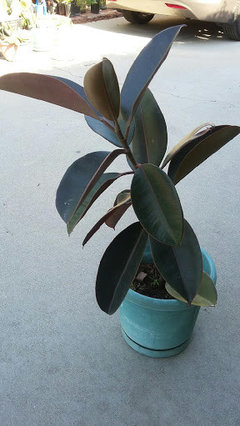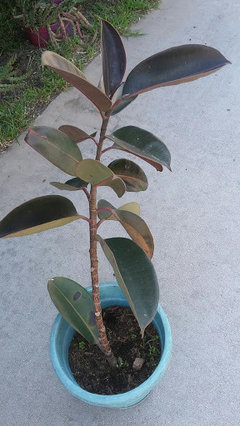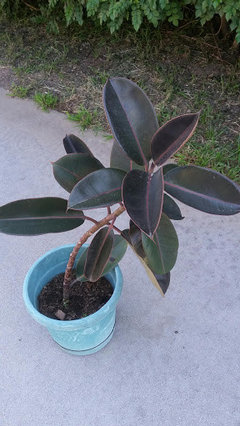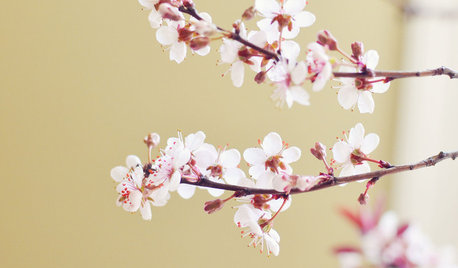Trimming/Propagating Rubber Tree
Hello all. My rubber tree is in need of a little trimming. Several of the branches are getting extremely long and the plant is looking somewhat lopsided. If I trim a few of the branches, can I root and directly plant the branch in new soil? Will a new tree start growing? Thanks for the advice!
Comments (186)
lesley1322
15 years agolast modified: 9 years agoHi i was wondering if you could help me. My dad has got a rubber plant in the most terrible condition, it was given to him by his father before he died almost 25yrs ago and because my dad really does not have green fingers at all he has basically left the tree to do its own thing since he got it.
The tree is about 5 foot tall and bends right over to almost touch the floor and its a very sorry sight. The trunk has two tiny branches coming off of it with very few leaves on each (only about 4) and a few leaves at the end with new ones budding. There is nothing else on the trunk what so ever (its just brown) and it clearly needs repotting as the soil looks very dry and odd.
Basically i was just wondering if there was any way that i could make the tree thicken out a bit and encourage new branches along the brown trunk?
i have very little knowledge of rubber plants and as the tree is almost an heirloom i really dont want to kill it. i would post a picture but i dont know how to do so.
if you could help me that would be great. thankyou.tapla (mid-Michigan, USDA z5b-6a)
15 years agolast modified: 9 years agoIf you can eliminate insects as the cause of decline, I think we need to look at the soil and condition of the roots as by far the most probable cause and work toward getting the rootage straightened out (not literally, lol) and the soil replaced.
I can save time by offering a step by step guide of what I would do if it was my plant. There are likely lots of salts in the aged soil that are preventing the plant from taking up water and the nutrients dissolved in it.
* Late in the day, move the plant to a spot where you can fully saturate the soil. Saturate it with room temp water & allow the plant to rest for a half hour or so. This allows the salt in the soil to dissolve into the soil water
* Flush the soil thoroughly by pouring a volume of room temp water roughly equal to to the volume of the container through the soil. o this at least 6 times.
* Depot the plant after it stops draining, and set it on newspaper over night. This will pull water reluctant to drain from the soil and prevent root rot if the soil is too heavy.
* In the AM, return the pot to the container and fertilize with a 1/4 strength solution of a 1:1:1 or 3:1:2 ratio fertilizer.
* Keep it warm (18-27*) and give it the best light you can manage. Water carefully. If you need more help on fertilizing and watering technique, let me know.
* When the plant begins to move into the more robust part of its annual growth cycle and has gained some energy reserves, we can get after the roots, which is probably going to be the key in getting the plant back on track. "To every thing there is a season, and a time to every purpose under the heaven."
Pictures would be helpful. If you can't post, you could email them directly.
Al
Related Professionals
Danbury Landscape Architects & Landscape Designers · McKinney Landscape Contractors · Andover Landscape Contractors · Brockton Landscape Contractors · Downey Landscape Contractors · East Haven Landscape Contractors · El Reno Landscape Contractors · Gaithersburg Landscape Contractors · Holland Landscape Contractors · Pine Hills Landscape Contractors · Placerville Landscape Contractors · Ronkonkoma Landscape Contractors · San Rafael Landscape Contractors · Tinton Falls Landscape Contractors · Wareham Interior Designers & Decoratorsguest123
15 years agolast modified: 9 years agoI should have posted here originailly. I have some rubber plants, fresh from the store. They are abot 2 feet tall. How do I take care of these so that they thrive? It would be great if someone could give me a short "how to" on rubber plants in terms of how often to water, how often (and what time of year) to fertilize and with what kind of fertilizer, whether to take them out of the rubber container I bought them in, and a timeline for when to put them in a pot and repot. I am keeping them inside. Thank you -
(P.S. last time I purchased rubber plants, I immediately put them in a pot with a 10 inch diameter, but the soil seemed to get moldy even though I didn't water them but once a week.)
tapla (mid-Michigan, USDA z5b-6a)
15 years agolast modified: 9 years agoI'll talk a little about potting up & what factors affect what is appropriate. No one can say whether the container size your plants are in is appropriate without fairly intimate knowledge of the state of the soil and how cramped the roots are, or an eye that has had some practice recognizing the symptoms of under-potting. Tight roots affect branch extension first, and o/a vitality soon after. The 'danger' someone else referred to in another thread should be associated only with slow soils. As I'll show in a moment, the danger of over-potting diminishes as soil particle size, aeration, and drainage increases. You can grow the tiniest of plants in huge volumes of soil if the soil holds no perched water.
"Over-potting" is a term that comes into play when there is a lack of basic knowledge/understanding about the 3-way relationship between plant material/soil composition/container size, which together logically determine appropriate container size(s).
It's often parroted that you should only move up 1 size in containers when "potting-up". The reasoning is that the soil will remain wet too long and cause root rot issues. Of course, that's true if you're growing in a heavy, inappropriate soil, but it can be remedied by changing the soil to one that drains freely.The size/mass of the material and soil type/composition determine both the upper & lower limits of appropriate container size. Plants grown in slow soils need to be grown in containers with smaller soil volumes so that the plant can use water quickly, allowing air to return to the soil. This (smaller soil volumes) will cause plants to both extend branches and gain o/a mass much more slowly. Rampant growth can be had by growing in very large containers and in very fast soils where frequent watering and fertilizing is required - so it's not that trees necessarily rebel at being potted into very large containers per se, but rather, they rebel at being potted into very large containers with a soil that is too slow.
We know that there is an inverse relationship between soil particle size and the height of the PWT in containers. As particle size increases, the height of the PWT decreases, until at about a particle size of just under 1/8 inch, soils will no longer hold perched water. If there is no perched water, the soil is ALWAYS well aerated, even when the soil is at container capacity (saturated).
If you wish to grow in a large(r) container - please do. Just be certain that your soil supports no, or very little perched water.
"... how often to water" - don't water on a schedule. Water when the soil feels dry at the drain hole. Soil will feel dry to you when it has between 40-45% moisture content. Most plants (including Ficus e.) can extract water from soils with a water content as low as 30%, so there is a 10-15% safety net built into testing soil for dryness at the drain hole.
"... how often (and what time of year) to fertilize and with what kind of fertilizer" I think you will find some good information about seasonal fertilizing here. If you are using a well-aerated soil and proper watering technique, you can fertilize frequently at low dosed all year long to good effect. It's important that you understand some basics, though.
"... whether to take them out of the rubber container I bought them in, and a timeline for when to put them in a pot and repot" That's all covered above.
"I am keeping them inside." Of course it's your call, but they would be much happier and grow much faster/better outdoors acclimated to full sun when temperatures allow (nights consistently above 50-55*).
Al
guest123
15 years agolast modified: 9 years agoTapla, thank you very much.
Well, an immediate concern is the general asthetic appearance of the plants, which seemed somewhat fine when immediately brought home from the store - there are two of them - but now one seems to have gone to the Dark Side: it's leaves are curly and gastly, it's color a dark and dingy green and not at all the luscious green of a nice, well-behaved rubber plant.
Incidently, it's disturbing appearance is shared with the likewise "wild" look of two small peace lilys, also recently purchased: these three plants are depicted below, and are in stark contrast to the first of the two rubber plants I purchased a week ago which seems to have maintained some semblance of house training.
Here is the misbehaving rubber plant - it's curly leaves (admittedly, I have not yet wiped them down) and swampy look are threatening to result in an immediate issuance of extradition papers should he or she fail to right him or herself:
Here are the likewise swampy looking peace lilys, equally disturbing in their countenance:
And here is the only chap who seems to have carried him (or herself) almost fashionably - in fairness, this one has been exposed to a fair helping of classical music since arriving at our previously modestly but sensibly appointed apartment - that is, until the other three plants (the other rubber plant and two peace lilys) crashed the party with their drunken, dishevled and downright palish appearance; here again, the only decently behaving rubber plant (who, too, is beginning to show signs of going to the dark side - it's leaves threatening to curl):
This last one's appearance - more symetrically disposed - I attribute to classical music, which seems to help plants grow more, well, symetrically.
But all in all, help is needed with them all, and particularly the other rubber plant and two peace lilys. These are NOT the kind of specimens that the Victorians would have found pleasing to the eye, notwithstanding their apparrent popularity in that era, as I understand it. What have I done to cause this?
pirate_girl
15 years agolast modified: 9 years agoI don't think these are bad looking except maybe for the water spots.
I'll leave the Ficus for Tapla to address, but what pls. do you feel is swampy lookin' abt the Peace Lillies? They look OK to me.
tunatamer4
15 years agolast modified: 9 years agoWe have a rubber tree that gets put outside every spring and brought back into the house for the winter. It usually stays outside until the night temps are predicted to drop into the low 40's.
Anyway, during the time it is outside it grows vigorously, getting watered once a week. When we bring it in in the winter, it sheds almost all it's leaves starting around the beginning/middle of February.(we normally bring it in around the middle/end of November. This has been going on for a couple of years.
Two questions. Is there a way to stimulate growth from the main trunk? We have clipped the growth bud from the top and all it did was shoot off another branch from that spot. Now it's about six feet tall with one branch poking out the top that has about four or five leaves left on it.
There were two other branches at the base that we cut off and replanted, that were doing quite well but they too are now dropping older leaves. All continue to grow new leaves but it is just a few at the very end of the trunks. They are just stalks with a few leaves on them.
What can I do to keep them looking healthy and fill them out a little?I have a couple of picturs but don't know how to post them.
Thanks for your help.
Marktapla (mid-Michigan, USDA z5b-6a)
15 years agolast modified: 9 years agoIs there a way to stimulate growth from the main trunk?
This is a question/answer from a recent post - it helps explain ..... "Typically when you tip prune on ficus does it usually produce one single new branch or several? How far down will the dormant buds be activated?"
It sort of depends on two things that usually, but not always, go hand in hand - the time of the year, and the tree's vitality/energy level. If you were to prune in Jul-Aug, at the peak of vitality, likely all the latent axillary buds would be activated on that branch behind the pruning cut, and in some cases, it can even stimulate additional bud activation on other branches - especially if you tip prune several branches @ once. If you prune when energy levels are low, the tree is more likely to back-bud with less proliference. It may even send up/out only one or two weak branches/branch until cultural conditions improve, or at least until energy levels are increased.If you have more questions about this, please ask.
We have clipped the growth bud from the top and all it did was shoot off another branch from that spot. Now it's about six feet tall with one branch poking out the top that has about four or five leaves left on it.
Terminate that branch as you did originally. As you see new buds emerge in locations you think are unfavorable, rub them off immediately. Your tree WILL back-bud, but sometimes you have to give it directions. ;o) If your tree was growing with good vitality when you cut it back, it would have back-budded more vigorously. I have purchased species of F benjamina that began as 7-15' tall trees & had been cut back to a short leafless stump (for bonsai). Within a couple of weeks, they were bursting with growth.
There were two other branches at the base that we cut off and replanted .... what can I do to keep them looking healthy and fill them out a little?
Tip prune as directed above, They too will back-bud.
I have a couple of pictures but don't know how to post them.It would be helpful for more specific advise & perhaps a better timetable if you could mail them to me. Knowing your zone & where you live would also be helpful.
Al
mystiblu
15 years agolast modified: 9 years agoHello Al and all,
My rubber tree plant is 8 years old and this past winter I noticed, for the first time, leaves drying up and falling off, mainly at the ends of the branches. I think I may have under watered it, because I have it in a sunroom and its kept in a good temperature with plenty of sun. There's new growth at the base of the plant so that's good, but a the end of the branches, they're bare. I want to prune the plant, but I'm afraid to cut all those bare end branches, that I may do something wrong. I normally would cut some of the branches, lessening the work for the plant, but is it all right to cut the end of the branches that are bare that way? I question if there would be new growth, cutting the ends that way. The leaves right now all look a bit droopy and I've begun to water it more as the weather here in Virginia is getting warmer. I normally have it outside all spring, summer and fall, only bringing it in, in the winter. It's getting heavy, but we are still able to bring it in right now. It's a pretty well rounded plant, but it looks a bit run down right now and bare on the ends, please help me know how to cut it back. I'm positive about it seeing new growth, but don't want to cut back the braches and do harm. Also, I've never given it plant food or anything, (I sound horrible I know, but its been a very healthy plant), should I begin feeding it, what do you recommend and should I feed it after I prune, or wait a bit? It doesn't seem to be pot bound, it seems to be ok there. Thank you for your help.tapla (mid-Michigan, USDA z5b-6a)
15 years agolast modified: 9 years agoWhen you water, are you watering thoroughly so the soil is evenly saturated and an abundant volume of water is escaping the drain hole immediately after watering?
I'm always reluctant to prune a struggling plant unless I know the tissues I'm pruning are actually dead; but then I'm usually dealing with a plant that has foliage at the ENDs of branches with foliage spare more toward the center of the tree. There would be very little harm in pruning bare branches back to a viable leaf on your plant, so go ahead. If you can post pics or mail them, I could probably offer more specific guidance.
I'm very surprised that your tree hasn't become severely weakened w/o supplemental nutrition. Yes, I think you should feed it. I would suggest MG All Purpose fertilizer (they make 2) in either 24-8-16 granular (in a box) or 12-4-8 liquid (in a plastic qt container). After the tree recovers, and if you're up for it, we can get after the roots & see if we can't rejuvenate the entire planting & get it back on track.
Getting it back outside when night temps are reliably above 55* will make a world of difference.
Al
lschawe
15 years agolast modified: 9 years agoI have a rubber tree that I have had for over three years now. It lives in my house and is now about five feet tall. However the bottom foot of the tree has no leaves and its becoming to tall to support its self. What can I do to help my poor tree out?
tapla (mid-Michigan, USDA z5b-6a)
15 years agolast modified: 9 years agoHow many branches are on the tree and how many leaves on each branch (approximately)?
Al
lschawe
15 years agolast modified: 9 years agoThere at four main branches coming up from the soil and I would say at least 12+ leaves on each branch.
Liz
tapla (mid-Michigan, USDA z5b-6a)
15 years agolast modified: 9 years agoCut the top branch back to 2 leaves. The next one down to 4 leaves, and the other two branches to 6-8 leaves. This will force back-budding and growth from leaf axils (crotches). Tie one of the new branches that will emerge, which ever one you want to be the new leader, to the trunk so it grows vertically - you'll be using the trunk as a stake. When the new leader has 3-4 leaves on it, sever the old trunk immediately above the new leader. Presto - your tree is shorter AND stronger, and also in the process of filling out.
Starting this summer, when the 4th leaf begins emerging on ANY branch, cut that branch back to 2 leaves. You'll be amazed at how 'bushy' your tree will be a year from now. You'll also have dozens of branches to make your pruning choices from, instead of 4. ;o)
AL
rc_rachelcomey_cim
14 years agolast modified: 9 years agoHello,
Love this thread!
I have a rubber tree that seems to be growing taller and thinner all the time, but there are leaves scattering all the way up the four tall stems. Should I prune it back? How?
Also, recently I noticed the top leaves developing a scratchy yellow color and the leaves seem slightly droopy.Any advice is super appreciated!
Thanks!!nsandomirskaya_hotmail_com
13 years agolast modified: 9 years agoIf I will put long cut branches of rubber plant into water, would it give roots? I did it 1-2 weeks ago and it is standing outside in a bright light, but I don't notice any sighns of rooting. Please suggest. Thanks
kduncan4_mac_com
12 years agolast modified: 9 years agoHello! I have had a rubber tree that started as a tiny cutting for a few years now- it is now close to 8 ft tall- but is just one long stem- it never branched out- is it too late to get this tree to start branching? How would I go about strengthening this tree?
billh33_verizon_net
12 years agolast modified: 9 years agoHi - my brother-in-law gifted me with a rubber tree plant that was too big for his living space, feeling that I had more space and more patience to take care of it.
The plant is about 4.5 to 5 feet tall above the top of the soil.
The pot is 19" wide and 22" tall.
There are about 15 main stems .5" to 1" thick
And they are spreading out a bit to a space of about 6 feet in diameter.
They are getting new leaves and new branches, although some of the leaves that have come out since it was moved to my house are not fully green and are not shaped right, not flat but curled up a bit.
Because my brother-in-law was trying to keep the plant short, the stems have been cut (or broken) and there are several branches o each stem.
It may be relevant to note that my brother-in-law took the plant out of the pot to fit in his car when he brought it over to my house, which may explain why some of the new leaves are curly and 3 or 4 of the old leaves yellowed and came off.My questions are:
Do I need a larger pot now or at some future point and if so, how do I know when?
Is there anything special I need to do to help it recover from the shock of the move?
How much time should I give it to settle in before I prune it to grow into the space I have for it?
It is on the lower floor of a raised ceiling where it can potentially grow to be up to 18' tall (if rubber tree plants can get to be that tall) and a skylight window is the only source of light.
How ever it is constrained by a staircase going around it from the lower to upper level.
I need it to fit in a 3' x 4' space until it is 6' tall (above the soil) then 3' x 7' until it is 9' tall then 6' x 7' at it widest.
How do I determine how may branches to prune off, which branches to prune off and what is the best method training the stems to go in the desired directions?
I suspect stakes are helpful at first, but...
What material (plastic, wood, other)?
How long can/should the stakes be?
What do I secure it to the stakes with (plastic ties, rope, other)?
How forcefully can I re-direct the stems?
Is there anything I can do once the plant has outgrown the stakes?Thanks
m_ryno
8 years agoHello, My rubber tree is 35 years old and crazy big and taking over the room as well as all the light from the two windows it is near. The leaves are getting dull and kind of scrapy. I was considering a bigger pot because I think it is root bound but the cheapest pot that is large enough is $215. Will it do o.k. if I just prune it? Thank you so much for any help you can give me.
Ryno
tapla (mid-Michigan, USDA z5b-6a)
8 years agolast modified: 8 years agoAs root congestion increases, vitality and growth are diminished. Potting up to a larger pot will temporarily and only partially relieve the limitations associated with root congestion, so ideally you would repot instead of potting up. Not only is that better for the plant, it would also allow you to use the same pot or a smaller pot. There's much more to talk about, but first let's see how willing you are to take the plunge.
Pictures?
Al
m_ryno
8 years ago Thanks Al! It's so nice to know there is someone out there with some knowledge that can save my rubber tree. I am attached and would love to do what it takes to help her and help us get it to a manageable plant. I would love to see her leaves shine once again! It seems like good news that I do not have to buy a bigger pot. What is repotting exactly? Thank you again! Mary
Thanks Al! It's so nice to know there is someone out there with some knowledge that can save my rubber tree. I am attached and would love to do what it takes to help her and help us get it to a manageable plant. I would love to see her leaves shine once again! It seems like good news that I do not have to buy a bigger pot. What is repotting exactly? Thank you again! Mary
tapla (mid-Michigan, USDA z5b-6a)
8 years ago
Repotting will be a chore the first time you do it, but subsequent repots - much less so. It includes bare-rooting the plant, pruning off about 1/2 of the roots with emphasis on removing large roots not directly attached to the trunk at its base, and transplanting back into the same pot (in this case) and an appropriate soil. An 'appropriate soil' is one you can water to beyond saturation, so you're flushing accumulating mineral salts from the soil when you water, each time you water. This not only helps to keep the level of dissolved solids in the soil solution (the soil solution is water + dissolved minerals in the soil) as low as possible w/o incurring nutritional deficiencies, it also helps you take and maintain control over nutritional supplementation, which should be a part of any form of container culture. Read this list about the Cultural Preferences of Ficus in Containers. It should help you with how to better care for your plant. It's written about Ficus benjamina, but the cultural preferences of elastica vs benjamina are essentially nil.You'll also find information about How to Maintain Trees in Containers over the Long Term if you follow this embedded link. They should provide a very good framework from which to operate. Let me know if you'd like to read info that provides a basic overview of growing in pots. That should also serve you well. Once you've gained a general understanding of the 'Whys', we can formulate a plan of 'Hows'.
AlMegan Smeznik
8 years agoHello, this is my first time posting on here and I hope someone can help me. I have a rubber tree that is probably about six years old now. I got it in college and well it almost died because the place the college got it from was awful. I do not know much about rubber trees but I have been trying to care for it as best as possible. It only has one main trunk. It doesn't have any branches. It lost those early on when I received it. The plant was crooked when I first received it and I staked it and attempted to train it to grow in another way. Well, long story short, that did not work out well. Now the plant cannot stand up on its own and I cannot correct it due to its woodiness it has now on its main trunk/ stem. What can I do to save my plant? My car currently is holding it up until I can stabilize it. I've attached pictures for reference.
tapla (mid-Michigan, USDA z5b-6a)
8 years ago..... would like to see the pictures, but pulling a plant back from the brink requires a willing interventionist. The usual formula goes something like:
Flush the soil next time the plant needs watering.
Fertilize immediately after flushing the soil and institute a good nutrient supplementation program.
Get and keep your watering under control.
If possible, move the plant outdoors as soon as temps allow - nights reliably above 55*.
Repot the plant into an appropriate medium at the first favorable opportunity. An appropriate medium is one you can water to beyond the saturation point (so you're flushing accumulating salts from the soil when you water) w/o having to worry your soil will remain soggy so long it wreaks havoc with root function/health. For a large part of the country, Father's Day is a good focal point ....... or a little earlier (early June) if you live in the deep south. Repotting is much more extensive than potting up as it includes bare-rooting the plant, root pruning, and a complete change of soil. Usually, a smaller pot can be used after repotting, or the plant can be returned to the pot it was in.
That's a general outline. If you're interested in putting a detailed plan together, let me know.
AlMegan Smeznik
8 years agolast modified: 8 years ago megan_smeznik's ideas · More Info
megan_smeznik's ideas · More Info
Hi Al,Thanks for responding. I apologize I thought the photos attached of the tree but they did not go through. I might have not been specific enough in my last post. The tree fell over and now is currently propped up by the wall. The tree is about 8 ft tall and still growing. It does well over all except the fact that it has grown crooked and won't stand up on its own now. It has nice deep, green shiny leaves and no pests. I live in Ohio so taking it outside right now is not a good idea overall. I am trying again with the photo. If you could provide a more detailed plan that would very helpful. Thanks again.
tapla (mid-Michigan, USDA z5b-6a)
8 years agoIf your tree looks anything (now) like it looks in the picture, the fix is easy. Cut the top off at about the ht of the middle door hinge, ensuring you make the cut so a leaf faces upward after the tree is straightened. Straighten the tree up by repositioning the roots in the pot so the trunk comes out of the soil at the pot's center and a leaf faces upward directly above the pot's center. You might need to prune off part of the root mass in order to accomplish the operation, but that's no problem if you're removing a large fraction of the top mass. Alternately, and a better approach would be to follow my initial plan.
The plant is very starved for light, so anything you can do on that front would be considered a big plus, from the plant's POV.
Alm_ryno
8 years agoHi Al,
I am thinking of cutting the roots soon. I will go out and get the good soil and if there is a link to the actual process of cutting, it may be difficult without breaking some branches since I have my crazy 30 year old rubber tree. Do I cut back any of the branches as well? Thank you, Mary
tapla (mid-Michigan, USDA z5b-6a)
8 years agoI'm used to being very direct about trees, and nothing I'm going to say is meant to be demeaning. I want you to to be confident in your ability to wrest control of your plant's growth away from the plant so you're setting the course instead of nature. You can see what nature's way has produced - you can do much better. What I think I'm seeing when I look at your tree is someone who's been unsure about what would happen to the tree if you had restrained it's ungainly growth. That's a very common issue with hobby growers who might not be familiar with the merits of pruning to keep their plants in bounds, so don't feel like I'm singling you out - you're not alone. A very high % of growers think, "If my plant puts it there (growth), I'm obligated to accommodate it", which is (I'm thinking) why your plant is taking over the house.
I'll make a proposal that (I'm sure) will bring the tree back around to something you can manage and can build on. It will be drastic, so you'll need to decide if you trust me enough to move forward on my recommendations. I'll outline it:
* At an appropriate time (depending on where you live) you should cut the tree back to something you can move outdoors. More pictures will help me help you decide where to cut.
* The tree gets cut back and moved outdoors when appropriate.* The tree gets repotted, which is going to be a chore. It will include cutting the bottom 1/3-1/2 of the roots off, then bare-rooting and pruning out the remaining problem roots before repotting into an appropriate medium - reusing the same pot or one smaller. If you decide against repotting as opposed to potting up or leaving the plant in the same pot, you should expect continued decline. The plant will not self-restore to even a reasonably good state of vitality w/o significant intervention (that includes root work) on your part. Perfect light, watering, and nutrition, at this point, might make a small difference, but what's needed is root work.
* After repotting, the plant will start to back-bud. At this point, the major pruning can be undertaken and will probably consist of reestablishing a trunk line. After that, the tree should be allowed to grow for a year w/o pruning. Starting in summer '17, you should start a regular annual pruning, followed by regular pinching during the growing season.
This is the BASIC outline with little 'how to' detail. I won't bother with instructions unless you decide you want to make the effort I just described to revitalize the tree. It will probably take 1/2 day to repot and whatever time it takes if you decide to look into making sure the soil you use is appropriate. What would make things VERY easy is if you could find a source for pine bark in a suitable size. We can also address nutritional supplementation (fertilizing) once you set your course.
Alm_ryno
8 years agoHi Al,
Thank you, thank you! I am excited to do the repotting. I understand the concept of letting the tree go the way it wants and am determined to get it under control and healthy. I like the psychological aspect of the way some of us relate to the concept of growing. I live near the beach in central California and am not sure it wouldn't be too cold and foggy at times for her. I have already acquired most of the soil. The small fir bark and peat (sphagnum) I just now need to get the garden lime or dolomite. I heard Home Depot has small bags. I would love to put the rubber tree into a smaller pot but I am not sure how that would work with the gangly branches that are now there spread out all over. I am also worried about accidentally breaking off branches in the midst of trying to cut the bottom 1/3-1/2 of the roots off. I may be able to get to the repotting on Friday if I am lucky.
Mary
tapla (mid-Michigan, USDA z5b-6a)
8 years agoI think that your immediate focus should be on getting your tree back to a reasonable state of vitality, then get a decent trunk line established. It's likely that ALL of those gangly branches will go away, so don't worry about breaking one or more.
I wouldn't b e in a hurry to repot. If it was my tree, I'd wait until mid-June to do the repot. Keep reading up on soils, repotting techniques, and general long term care of woody plant material in pots so you're very familiar with both 'how' and 'why' before you move ahead.
Alm_ryno
8 years agoHi Al,
So, I was wondering if you suggested me to wait until mid-June to do the repot because of the time of year or just to get myself more familiar with the process? Oh, yeah, you did say to get my tree back to a reasonable state of vitality. Are there some vital things that I could do to get my tree back to a reasonable state of vitality? Any suggestions would be so appreciated. She is going down hill.
Thank you,
Mary
tapla (mid-Michigan, USDA z5b-6a)
8 years agoActually, getting familiar with the process and taking the time to make sure you're going to be providing a soil for your plant that allows you to water correctly important parts of your skillset, So I'm certain you can't go wrong and wouldn't be wasting your time. Repotting or pruning in June offers your plant the best chance at a faster recovery and ensures the growth that comes in after you prune will be tight/compact, which, if you get in the habit of pruning in June will help you keep your plants nice & full because you'll be cutting off all the long winter growth each season.
It will explain a lot about decline and how to reverse it. If you have questions or need anything explained in more detail, please don't hesitate to ask.
AlPaloma Ruafigueroa
7 years agolast modified: 7 years agoHello Al,
I need some help with my rubber plant. I have it since 7 years ago. Since two years ago that I left my plant with a friend for 6 months, my plant is being loosing its leaves, they start turning yellow and then they fall, and now it is looking like the pictures attached, what should I do to stop it? Its looking very ugly without any leaves at the bottom, I thought the leaves would grow back but they haven't. Should I trim the branches to have leaves at the bottom again? I water it once every two weeks, and now during spring and summer once a week, I give it baby-bio plant feed once a month. Thank you very much in advance, Paloma. (Btw I live in London)
Sorry for some reason is not letting me upload the pictures
tapla (mid-Michigan, USDA z5b-6a)
7 years agoI have ideas, but probably going to need to see the pics. If you send me a Houzz message, I'll send you my email & then you can email them if you can't upload them.
Altapla (mid-Michigan, USDA z5b-6a)
7 years agoThe plant has the look of a severely root bound plant, yet there aren't roots 'crawling' all over the top of the soil. Is that because you recently potted up? You can cut this plant back very hard, but it would be best if you could coax it back to a better state of vitality before you do that (insurance against it being too weak to tolerate the heavy pruning). Is there any chance you could get it outdoors when temps allow?
AlPaloma Ruafigueroa
7 years agoThank you for your response. I changed the pot last September, the one it previously had was half of the size or a bit smaller. I could put it outside soon as the weather is getting warmer, do I still have to change the pot again? It doesn't look small for it to be fair, but I could check the roots, would that help to get it healthier? How do i know when its good enough for pruning?
Thank you, Paloma
tapla (mid-Michigan, USDA z5b-6a)
7 years agoIf the plant was suffering from root congestion and all you did was move the plant to a larger pot w/o correcting the congestion in the original root mass, it's still suffering from root congestion and the only way to fix that is to repot.
For others following this thread or those who might read this post later, I'd like to say that this catch 22 is where failure to repot at appropriate intervals inevitably leads. We have a plant in decline that needs to have that decline reversed before it can be repotted, The problem is, it needs to be repotted to reverse the decline. Ideally, we would include repotting (includes root pruning and a change of soil) instead of potting up as a regular part of our maintenance program.
I wasn't admonishing you or ridiculing you, Paloma - just taking advantage of the situation to offer a learning opportunity and stress a point I make as often as possible.
What we need to hope for is the partial lifting of the limitations imposed by root congestion that remain when the plant is potted up. I think the plant would benefit if you depotted it and removed the loose soil from around the edges. If you have the original pot, I would return it to that pot and flush the soil thoroughly by pouring room temp water = to at least 10X the volume of the pot through the soil. After it stops draining, I would use a utility knife (or equal) with a fresh blade to make several deep vertical cuts on the outside of the root mass and an 'X' in the roots at the bottom. That done, I would return it to the larger pot on top of 5 cm of soil and fill in around the edges with fresh soil. From that point on, I would monitor the plants water needs carefully to ensure you do not over-water, and I'd fertilize the first time the plant needs water after you complete the above.
If that works, you can cut the plant back hard in late June and it will back-bud for you within 2 weeks. Make sure you ask any questions you might have, or about anything you're unsure of. It looks like a full repot should be planned for June of '17.
Read this if you're concerned that the soil might remain saturated for an extended interval after you water.You might also find this basic overview helpful. It will help you avoid all of the most common obstacles faced by hobby growers.
Al
m_ryno
7 years agoHi Al, I am trying to strengthen before repotting in June and I am wondering about the flushing of my very large potted rubber tree that is not really moveable and is situated in a carpet area. Do you have any suggestions on how to accomplish this without a soggy mess? Also, any fertilizer that is better than another? I have used Romeo 18-18-18 All purpose garden fertilizer in the past. Thank you, Mary
tapla (mid-Michigan, USDA z5b-6a)
7 years agoI'm pretty handy & have a lot of tools that take much of the work out of moving heavy/bulky stuff around - so not much of an issue for me ...... as long as I can get it through the door, and I have a saw & loppers, so that's never a problem, either. There's no getting around the fact that if you're going to pour water = to 10X the volume of the pot the plant is in through the soil, the water must have somewhere to go. I've used refrigerator dollies and moving dollies with 4 wheels to move heavy and awkward plants I've repotted for myself & others. Beyond using your imagination and the strongest backs you can convince to cooperate with you, I can't offer much more help.
I'm partial to soluble fertilizers because I like the control. Slow release, or controlled release (like Osmocote), don't offer that degree of control, but they can serve well in container applications, especially for those with a tendency to forget applications. I also prefer fertilizers in a 3:1:2 or 2:1:2 ratio instead of the 1:1:1 ratio you're using. Examples of 3:1:2 ratios are 24-8-16, 12-4-8, 9-3-6. I'm particularly happy with the results I get using Dyna-Gro's Foliage-Pro 9-3-6, and heartily recommend it as your 'go to' fertilizer for house plants because it allows you to get the most from the least. What I meant by that is, fertilizers that closely match the ratio at which the plant actually takes up the nutrients allow you to have the lowest o/a fertility level possible (EC/TDS) w/o experiencing deficiencies. There is significant benefit in that.
Alrach1988
7 years agolast modified: 7 years agoHey! I have a rubber tree that is quite small, maybe 40cm tall, but it has lots of branches that are rooted. Almost like different stems, am I able to separate these? are re pot as single plants??
I also have a larger single trunk rubber tree that has just lost all its leaves at the bottom but sprouted 3 at the top really quickly... it is about 1.5m tall so looks a bit weird. is there any way to save it??thanks!! i really appreciate any feed back!!
Jontte Kinnu
7 years agoI use fine orchid mulch with many of my houseplants, including Ficus elastica. It seems to like low pH enviroment(5) and really well draining soil.
I dont know if acidity has something to do with this, but its growing nice and loves quit heavy fertilization.
I pruned it when it was 25cm long, and now it has 2 vertical branches. I plan to trim it later in spring, and hopefully it does grow more branches. I did prune it in october when it was under my growlights, lets see how it reacts getting pruned in strogn filtered light..
Regular misting and some heavy misting focused on the trunk made it to grow two nice aerial roots 5cm off the soil level. Now they have reached the soil and are thickening up nicely. Hopefully some heavy root pruning in years to come makes them thicken up even more..
My attentions were to train it as bonsai, but my wife liked it this way better, so let it be as it is. :) I'm just not going to let it be monsterously big. 1,5 meters max.
tapla (mid-Michigan, USDA z5b-6a)
7 years agoRach - Sometimes, the greenhouse will stick (an actual horticultural term) several individual propagules in a single pot; and sometimes that will stick a single propagule (cutting) in a single pot. Because there may be several nodes on a propagule, and each node is place from which branches often occur, you won't really know if you're dealing with multiple stems from a single propagule or several propagules, unless you dig around in the roots a bit. If they're separate propagules, you can separate them at repotting time. If they're all attached to the same propagule you can remove as many stems as you like by cutting them off flush to the main stem. You can then try to root each propagule individually or in a 'clump' arrangement.
You can often tell, if the plant isn't too root-bound, if the stems are all part of the same propagule if you hold one stem and move another around a bit. Sort of like, shaking one limb of a small tree makes the whole tree move.
Jontte - F elastica doesn't make a good bonsai subject because its large leaves don't respond well enough to leaf (size) reduction techniques to keep it's leaves in proportion to the size of the tree. There ARE many ficus trees that have the same cultural wants as your rubber tree, but have smaller leaves and much shorter internodes./ There are several varieties of benjamina that are suitable. Also, salicifolia/nerifolia, retusa, microcarpa, are all good. You can also train F pumila to an upright position and get some really nice looking weeping style bonsai with little more skill than it takes to ensure the tree's good health.
Al
rach1988
7 years agoThank you so much Al,
Also wondering about my single stem tall rubber tree that has just lost all its leaves at the bottom (lost about 8 overnight!) but sprouted 3 at the top really quickly about 2 weeks ago... it is about 1.5m tall so looks a bit weird. is there any way to save it??
Jontte Kinnu
7 years agoAl: I do have F. microcarpa(mallsai, the gingseng/root thing) and F. benjamina as bonsai projects. F. elastica isnt suitable as a small bonsai, but I quess with years of patience(as with all bonsais, neverending projects..) you can make it a larger bonsai. Enviroment plays a big role, and I think I've got it right.
But, my wife likes it as it is so I'm not going to train it any further, except what comes to aerial roots. It doesnt seem to be too tricky what I've experienced so far. But we'll see if I have room for it under lights the coming winter.. Although I've planned to get one 100w CFL more.
tapla (mid-Michigan, USDA z5b-6a)
7 years agoRach - The surest way to 'save' a plant in decline is to improve cultural conditions that require the plant to operate at or beyond the limits it's genetically programmed to tolerate. I don't have enough information to allow me an educated guess at what the exact issue might be, but I can say that I believe at least 90% of the issues people come to the forums looking for help for, are related to root health ..... which depends a great deal on your soil choice and watering habits.
Let me recommend that you read this piece I wrote about Turning Sick Plants Around. You'll see a strong emphasis on the impact soil choice and watering habits has on root health. Hopefully, something will click that helps you formulate questions that will help you resolve issues you suspect to being limiting your plant, based on what you've read in what I've linked you to.
Al
James Hu
7 years agoHello, I'm about to purchase a Rubber Tree for indoor use from someone on Craigslist. The rubber tree I'm purchasing however has been outdoors for quite some time so it has not been acclimated yet. Furthermore, the rubber tree doesn't look that healthy to me. I've attached pictures of the rubber tree below. Does this tree look adequate and healthy enough to thrive in a "low light" environment (10a/10b, north-east window with lots of high rises blocking the sun)? I'm also concerned about its tilt. Thank you in advance! :)



tapla (mid-Michigan, USDA z5b-6a)
7 years agoThe degree to which a leaf can 'acclimate' to changes in photo load is limited. IOW, you can't expect a leaf that emerged under a full sun light load to acclimate to light levels in a dim corner, any more than you can expect a light that emerged in a dim corner to acclimate to a full sun site; this, no matter how long you allow for acclimatization. Too, the plant's ability to adapt to higher light loads is greater than its ability to adapt to lesser light loads.
Using a 1-10 numerical example (1 is low, 10 is high light) to illustrate: If a plant emerges where the light level is measured at 5 units, it's range of adjustment might only be 3.5 on the low side, but 8 to 8.5 on the high side.
Al
James Hu
7 years ago@tapla Thanks Al for your expertise. I'll try to find a Rubber tree that has already been acclimated indoors.
Sian Rowlands
6 years agoPlease help my rubber plant!!! I bought it when I became a homeowner 9 years ago and it moved house about 3 years ago. I think the room I put it in was too dark (shown behind which as you can see has a window that goes into another room! Quirky house issues) and slowly all its leave have fallen off and over the past month it's taken a dire turn! I've relocated it to this room, which ha one full wall of windows and roof windows. I'm too scared to do anything, the earth in the pot is old and all shrunken. The top leaves seem to have perked up since it's move to a brighter room, but if all the bottom ones fall off it will look rather silly! Help!!!
tapla (mid-Michigan, USDA z5b-6a)
6 years ago
Try reading this, then ask any questions you might have.Al



















PurpleRainbow